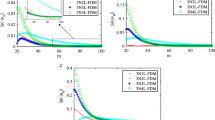Abstract
An improved full-discretization method (IFDM) based on the golden search is presented in this brief paper to predict stability lobe diagram (SLD). To begin with, the mathematical model of milling dynamics considering the regenerative chatter is expressed as a state space form. With the time delay being separated equally into a limited amount of elements, the time series expression is obtained by interpolating the integral nonhomogeneous term using linear approximation. Then, 2N order algorithm is adopted to resolve the exponential term into a real matrix, which avoids the exponential matrix that has to be calculated each time in scanning the plane comprised of axial cutting depth and spindle speed. Lastly, the golden search instead of traditional sequential search is applied to seek the crucial axial cutting depths corresponding to different spindle speeds, which can improve computational efficiency remarkably. The verifications with two classic benchmark examples demonstrate that the proposed method has higher computational efficiency.
Similar content being viewed by others
References
Sridhar R, Hohn R, Long G (1968) A stability algorithm for the general milling process: contribution to machine tool chatter research—7. J Eng Ind 90(2):330–334
Altintas Y, Budak E (1995) Analytical prediction of stability lobes in milling. Cirp Ann-Manuf Technol 44(1):357–362
Merdol S, Altintas Y (2004) Multi frequency solution of chatter stability for low immersion milling. J Manuf Sci Eng 126(3):459–466
Bachrathy D, Stepan G (2013) Improved prediction of stability lobes with extended multi-frequency solution. CIRP Annals-Manuf Technol 62(1):411–414
Ozturk E, Tunc L, Budak E (2011) Analytical methods for increased productivity in five-axis ball-end milling. Int J Mechatronics M 4(3–4):238–265
Sun C, Altintas Y (2016) Chatter free tool orientations in 5-axis ball-end milling. Int J Mach Tools Manuf 106:89–97
Li Z, Liu Q, Ming X, Wang X, Dong Y (2014) Cutting force prediction and analytical solution of regenerative chatter stability for helical milling operation. J Adv Manuf Technol 73(1–4):433–442
Balachandran B (2001) Nonlinear dynamics of milling processes. Philos T Royal Soc A 359(1781):793–819
Li H, Li X, Li H, Chen X (2003) A novel chatter stability criterion for the modelling and simulation of the dynamic milling process in the time domain. Int J Adv Manuf Technol 22(9–10):619–625
Insperger T, Stepan G (2004) Updated semi-discretization method for periodic delay-differential equations with discrete delay. Int J Numer Meth Eng 61(1):117–141
Zhou K, Feng P, Xu C, Xu C, Zhang J, Wu Z (2017) High-order full-discretization methods for milling stability prediction by interpolating the delay term of time-delayed differential equations. J Adv Manuf Technol 93(5–8):2201–2214
Long X, Balachandran B (2007) Stability analysis for milling process. Nonlinear Dynam 49(3):349–359
Ding Y, Zhu L, Zhang X, Ding H (2010) A full-discretization method for prediction of milling stability. Int J Mach Tools Manuf 50(10):926–932
Insperger T (2010) Full-discretization and semi-discretization for milling stability prediction: some comments. Int J Mach Tools Manuf 50(7):658–662
Long X, Balachandran B (2010) Stability of up-milling and down-milling operations with variable spindle speed. Journal Vib Control 16(7–8):1151–1168
Zhang X, Xiong C, Ding Y, Ding H (2016) Prediction of chatter stability in high speed milling using the numerical differentiation method. Int J Adv Manuf Technol 89(9–12):1–10
Tang X, Peng F, Yan R, Gong Y, Li Y, Jiang L (2017) Accurate and efficient prediction of milling stability with updated full-discretization method. Int J Adv Manuf Technol 88(9–12):1–12
Dai Y, Li H, Wei Z, Zhang H (2018) Chatter stability prediction for five-axis ball-end milling with precise integration method. J Manuf Process 32:20–31
Li M, Zhang G, Huang Y (2013) Complete discretization scheme for milling stability prediction. Nonlinear Dynam 71(1–2):187–199
Li Z, Yang Z, Peng Y, Zhu F, Ming X (2016) Prediction of chatter stability for milling process using Runge-Kutta-based complete discretization method. Int J Adv Manuf Technol 86(1–4):943–952
Funding
The authors are very grateful for the support of National Natural Science Foundation of China (51575075) and Collaborative Innovation Center of Major Machine Manufacturing in Liaoning.
Author information
Authors and Affiliations
Corresponding author
Rights and permissions
About this article
Cite this article
Dai, Y., Li, H. & Hao, B. An improved full-discretization method for chatter stability prediction. Int J Adv Manuf Technol 96, 3503–3510 (2018). https://doi.org/10.1007/s00170-018-1767-6
Received:
Accepted:
Published:
Issue Date:
DOI: https://doi.org/10.1007/s00170-018-1767-6



